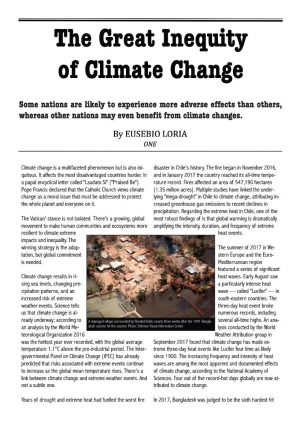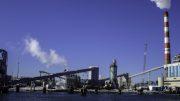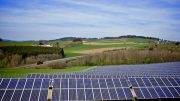 Climate change is a multifaceted phenomenon but is also iniquitous. It affects the most disadvantaged countries harder. In a papal encyclical letter called “Laudato Si” (“Praised Be”) Pope Francis declared that the Catholic Church views climate change as a moral issue that must be addressed to protect the whole planet and everyone on it.
Climate change is a multifaceted phenomenon but is also iniquitous. It affects the most disadvantaged countries harder. In a papal encyclical letter called “Laudato Si” (“Praised Be”) Pope Francis declared that the Catholic Church views climate change as a moral issue that must be addressed to protect the whole planet and everyone on it.
The Vatican’ stance is not isolated. There’s a growing, global movement to make human communities and ecosystems more resilient to climate extreme impacts and inequality. The winning strategy is the adaptation, but global commitment is needed.
Climate change results in rising sea levels, changing precipitation patterns, and an increased risk of extreme weather events. Science tells us that climate change is already underway; according to an analysis by the World Meteorological Organization 2016 was the hottest year ever recorded, with the global average temperature 1.1°C above the pre-industrial period. The Intergovernmental Panel on Climate Change (IPCC) has already predicted that risks associated with extreme events continue to increase as the global mean temperature rises. There’s a link between climate change and extreme weather events. And not a subtle one.
Years of drought and extreme heat had fuelled the worst fire disaster in Chile’s history. The fire began in November 2016, and in January 2017 the country reached its all-time temperature record. Fires affected an area of 547,190 hectares (1.35 million acres). Multiple studies have linked the underlying “mega-drought” in Chile to climate change, attributing increased greenhouse gas emissions to recent declines in precipitation. Regarding the extreme heat in Chile, one of the most robust findings of is that global warming is dramatically amplifying the intensity, duration, and frequency of extreme heat events.
The summer of 2017 in Western Europe and the Euro-Mediterranean region featured a series of significant heat waves. Early August saw a particularly intense heat wave — called “Lucifer” — in south-eastern countries. The three-day heat event broke numerous records, including several all-time highs. An analysis conducted by the World Weather Attribution group in September 2017 found that climate change has made extreme three-day heat events like Lucifer four time as likely since 1900. The increasing frequency and intensity of heat waves are among the most apparent and documented effects of climate change, according to the National Academy of Sciences. Four out of five record-hot days globally are now attributed to climate change.
In 2017, Bangladesh was judged to be the sixth hardest hit country out of 180 nations, during the 1996–2015 period. The high level of poverty and increasing population density, as well as limited adaptive capacity and weak local governance, turned the region into one of the most affected by climate change on the entire planet. Sea level in Bangladesh is rising while the country is sinking. Two-thirds of Bangladesh has an elevation of five meters or less, which leaves the country vulnerable to devastating natural disasters. Bangladesh is consistently cited as one of the most disaster-affected countries in the world, exposed to a variety of natural disasters including cyclones, floods, earthquakes, and landslides, and ranks first regarding vulnerability. The national population is increasing by two million people a year and is generally poorly funded to respond to natural disasters as the government is unable to help.
In 2007, after a series of floods and Cyclone Sidr, food security was severely threatened, and crop yields worsened. The loss of rice production was estimated at around two million metric tons (MT), potentially feeding 10 million people, effectively increasing the 2008 rice price and leading to about 15 million people without much food. Bangladesh is an example of how a rise in sea level and global temperature could lead to displace millions of people. Improving the country’s biodiversity is essential to prevent the depopulation and to sustain the development; resilience and adaptation are mandatory to avoid and fight next and future climate calamities.
Environmental risks are becoming more prominent than economic and geopolitical risks. Four of the top five global threats in the next ten years are related to climate change. Failure to respond to climate change has a massive impact on global risk.
The Global Risks Report 2018 (World Economic Forum, 2018) looks at five categories of environmental risks: extreme weather events and temperatures; accelerating biodiversity loss; pollution of air, soil and water; failures of climate change mitigation and adaptation; and risks linked to the transition to low carbon. The Paris Agreement, a legally binding international instrument designed to limit global warming to well below 2°C above pre-industrial levels, entered into force in 2016.
Climate scientists have warned that to avoid a catastrophic degree of climate change, the concentration of carbon dioxide in the atmosphere should remain below 450 parts per million. In 2016, the 400 parts per million limit was crossed for the first time, highlighting the urgent need for accelerated climate action among all global stakeholders, including governments, businesses, and civil society.
Acting on climate change means limiting risks around the world, for the benefit of future generations
Unfortunately, until now too little has been done globally to mitigate climate change. The likelihood of missing the Paris Agreements target of limiting global warming to 2ºC or below is greater than the possibility of achieving it.
However, these global temperature targets mask much regional variation that occurs as the Earth warms. For example, land warms up faster than oceans, high-latitude areas more quickly than the tropics and inland areas faster than coastal regions.
Furthermore, the warming felt by people is typically higher than the average global warming. Even in a world where global warming is limited to “well below” 2°C, there is still 14% of the world population experiencing temperatures + 2°C. In the worst-case scenario of continued growth in emissions, in 2100 about 44% of the population will experience 5°C warming – and 7% over 6°C (Source: Carbon brief, 2018).
Warming is not globally uniform. But who suffers the most from extreme weather events?
The most affected countries in 2016 were Haiti, Zimbabwe as well as Fiji. For the period from 1997 to 2016 Honduras, Haiti and Myanmar rank highest. Altogether, more than 524, 000 people died as a direct result of more than 11,000 extreme weather events; and losses between 1997 and 2016 amounted to around US$ 3.16 trillion. Storms and their immediate implications – precipitation, floods, and landslides – were one major cause of damage in 2016. According to the most recent scientific research, rising sea surface temperatures seem to play a crucial role in intensifying storms. Of the ten most affected countries (1997–2016), nine were developing countries in the low income or lower-middle income group, whereas only one was classified as an upper-middle income country (USA). Over 75% of the 31 million people displaced during 2016 left their homes as a result of weather-related events.
Fiji – hosting nation of the UNFCCC-COP23 and representative of Small Island Developing States (SIDS) – was severely affected by extreme weather in 2016. Cyclone Winston hit Fiji in February as a category five storm – making it the strongest cyclone on record for the archipelago. It resulted in significant destruction, especially on the island of Viti Levu, leaving over 44 dead and causing around US$1.4 billion in damages. Over 34,000 people became homeless, and infrastructure was severely damaged. Just six weeks after Winston wreaked havoc, Fiji was devastated by Hurricane Zena in April with top speeds of 105 Mph, forcing the evacuation of 3,500 people and the suspension of aid distribution.
Climate change is global for sure, but some nations are likely to experience more adverse effects than others, whereas other nations may even benefit from climate changes. People living in the least developed countries (LIC: Low-income countries) have ten times a more significant chance of being affected by a climate disaster than those in wealthy countries (HIC: High-income countries).
It will take over 100 years for LIC to reach the resiliency of more affluent countries, while the BRICS (Brazil, Russia, India, China, and South Africa) should be there in a 50-year time (source Notre Dame Environmental Initiative).
Different regions and different impacts need different solutions, and therefore winning strategy is mitigation through adaptation to climate change. Therefore fighting to climate change aims to motivate communities to build social, physical and natural systems that save lives and improve livelihoods, protect our environment, and strengthen market and policy positions.
Mitigation addresses the primary causes, by reducing greenhouse gas emissions, while adaptation seeks to lower the risks posed by the consequences of climatic changes. Both approaches are necessary. Even if emissions decrease in the next decade, adaptation will still be needed to deal with the global changes already in motion.
Humans have been adapting to their environments throughout history by developing practices, cultures, and livelihoods suited to local conditions. To name one: Vietnamese people build homes on stilts to protect against monsoonal rains.
Adaptation measures may be planned or put in place spontaneously in response to local pressure. They go from large-scale infrastructure changes – such as building fences to protect against sea-level rise or improving the quality of road surfaces to withstand hotter temperatures – to behavioral shifts such as individuals using less water, farmers planting different crops and more households and businesses buying flood insurance. Adaptation measures always imply costs that governments must support through incentive policy or subsidies. The IPCC describes vulnerability to climate change as being determined by three factors: exposure to hazards (such as reduced rainfall), sensitivity to those hazards (such as an economy dominated by rain-fed agriculture), and the capacity to adapt to those hazards (for example, whether farmers have the money or skills to grow more drought-resistant crops).
Adaptation measures can help reduce vulnerability – for example by lowering sensitivity or building adaptive capacity – as well as allowing populations to benefit from opportunities of climatic changes, such as growing new crops in areas that were previously unsuitable.
Within the Notre Dame Environmental Change Initiative, there is a program (ND-GAIN, http://gain.nd.edu) to enhance the world’s understanding of adaptation-resilience to climate change through knowledge, products, and services that inform public and private actions, and investments in vulnerable communities all over the world.
The UNDP (United Nations Development Program) works in nearly 170 countries and territories, helping to achieve the eradication of poverty and the reduction of inequalities and exclusion. It aims to help countries to develop policies, leadership skills, partnering abilities, institutional capabilities and build resilience to sustain development results. UNDP’s climate change adaptation works across six signature programmes to support vulnerable communities in building resilience to climate change: supporting integrated climate change strategies; advancing cross-sectoral climate resilient livelihoods; ecosystem-based adaptation; fostering resilience for food security; climate resilient integrated water resource and coastal management; promoting climate resilient infrastructure and energy.
The future generations and the poorest ones are the most vulnerable to the climate change impact and the most likely to suffer the most, without bearing any responsibility. The wealthiest people pollute, and the weakest ones suffer and pay the price. Tide should turn. The sooner, the better.
Eusebio Loria





